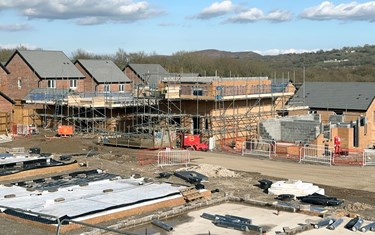Below are answers from policy officer Tom Kenny to written questions from the Housing Communities and Local Government Select Committee, following up on RTPI's original submission to their inquiry on the Supply of Social and Affordable Housing. You can download the response in PDF here.
The questions explore the roles of planning in securing social and affordable housing.
Introduction
I welcome the chance to provide evidence for the Housing, Communities and Local Government Committee’s inquiry into the long term delivery of social and affordable housing. I am glad the Committee has already taken on board some of the messages we promoted in our written evidence, and welcome the questions below. Today RTPI published Priorities for Planning Reform in England, a report designed to influence the upcoming Planning White Paper. It welcomes the government’s ambition and sets out the reforms we think would help meet its objectives. Since it covers data relevant to several of the questions here, I have attached it to this response.
In line with the Committees request (pasted below), this should be taken as my evidence rather than as a statement signed off by the RTPI.
Questions and answers
Q1 Will the Government proposals for the planning system— announced on 11 March 2020 and set out in the document, Planning for the Future—help deliver more social and affordable rented housing?
I welcome a number of the proposals set out in the Budget 2020 and Planning for the Future, however they do not go nearly far enough to address the need for social and affordable rented housing and some proposals will make it more difficult to deliver. See also the RTPI’s initial response to the proposals[1].
I welcome the support for local authorities to play a role in this delivery, including further support for compulsory purchase orders to aid land assembly. Our 2017 and 2019 research on local authority direct delivery of housing showed that the foundations are set for local authorities to play a larger role[2]. It is also good to see greater funding for infrastructure, which will help deliver housing of all tenures.
I welcome commitments to additional funding for affordable housing, and the explicit commitment to include social housing in the mix. However, the amount pledged amounts to around £2.4bn/ year for all ‘affordable’ tenures in the five years beginning 2022. This is far below estimates of what is needed to meet the need for social housing alone, estimated at £7billion a year by Savills[3], or £10.7billion a year for 20 years estimated by Shelter[4]. During the recovery from the impacts of Covid-19, a major housebuilding and regeneration programme could provide necessary stimulus and jobs. This would also free up developer contributions to fund infrastructure and placemaking interventions.
I am also concerned that proposals for First Homes, to be funded from developer contributions, will take funding away from affordable rented housing. We will provide more detail on this in our full response to MHCLG’s consultation next week and I would be happy to share this with the Committee if requested.
Q2 What safeguards are needed to ensure the repurposing of vacant commercial, industrial and residential land by developers meets affordable housing needs?
The RTPI strongly disagrees with proposals to allow for the unplanned demolition of vacant commercial, industrial and residential buildings to be replaced with residential units. This is not all new - in fact RTPI responded to a similar proposal in early 2019[5]. Permitted development should be for simple / minor changes, not new development on this scale. There is a clear tension between the Government’s aspirations for high quality new development and the continued expansion of permitted development rights.
We welcome proposals for safeguards, including for high quality design and natural light, to avoid some of the most shocking developments which have been shared widely in the media. However, this will not solve all the problems. Safeguards would also need to include:
- Locational considerations such as access to sustainable transport and green space.
- Space standards
- Fire regulations issues
- Building regulations issues
- Drainage concerns
- Residential amenity and open space concerns
- Utilities concerns with regard to access, capacity etc.
- Concerns with regard to impact on historical buildings and streetscape
Government would also need to ensure that the fees associated with the prior approval process were sufficient to cover the local authorities costs in processing the application.
Even with this all in place we might end up with a process no less onerous than a planning application, but with less chance for communities to participate, and no developer contributions towards local infrastructure and affordable housing. This would undermine the confidence in the local planning authorities and in the planning system more generally and cause confusion over what system applies.
Local planning authorities have a requirement in the NPPF to positively plan for all uses, including commercial. “Replacement build as residential” also misses opportunities for replacement for mixed uses which can be very important for place-making, general good design and local economy.
Q3 Is there a better way to deliver First Homes rather than through section 106 agreements, which may dilute the number of social and affordable rented homes?
If First Homes is to be introduced, it must come with a redoubled focus on affordable, high quality social housing with certainty of tenure. If this saving for individuals is paid for through reducing provision of social housing then it is questionable whether this is in the wider national interest.
In the RTPI’s response to the First Homes consultation (available on request), we suggest that if providing discounted first homes is a priority this could be funded directly by Government, for example by buying homes on the existing market, retrofitting them to current standards, and re-selling them as restricted price tenure. This might also provide an opportunity to contribute towards net zero targets by reducing embodied and operational emissions, while improving wellbeing and increasing resilience to flooding and overheating. Subdivision of larger properties may also be an option in some cases.
However, this would obviously require making the case that this is a good use of taxpayer money. Given that 30% discounts may still not enable most key workers to access these homes in most of the country, it is not clear this would be a good use.
I know there is a demand for this in some local authorities so we suggest it should be an option for the authorities that have an objectively assessed need for discounted market sale housing. However, more authorities have an objectively assessed need for discounted rent housing, so national minimums for First Homes are not desirable.
Q4 The Budget 2020 report states that: Land availability, as constrained by the planning system, is the most significant barrier to building more homes. Do you agree with the Government’s analysis?
I neither agree with this analysis, nor think that simply ‘building more homes’ is the most suitable way to meet the Government’s objective of affordable, safe, and secure housing for all.
Increase planning permissions approved in recent years have neither led to an equivalent increase in delivery, nor a reduction in house prices[6]. Planning permissions are not the same as new homes – planning has few powers to force permissions to be enacted or to be built out more quickly. The Letwin Review pointed towards structural features of the volume housebuilding market as being at the root of slow build out. The Committee will also be aware that the gap between new housing completions at its peak in the 1960s is rougly equivalent to the reduction in homes built by local authorities.
Rather than being a barrier to development, planning plays an important role in overcoming constraints to increasing land supply for housing, including by preparing land for development, resolving ownership constraints, and bringing forward investment by ensuring the right infrastructure is in place[7].
Furthermore, the relationship between market housing supply and affordability is neither simple nor direct. Empirical analyses, including from the Bank of England[8], indicate only a weak relationship between land supply, housing supply, and rates of house price growth[9], and almost no relationship between land supply and the other factors that impact affordability such as transport costs, energy bills, food expenditure, and access to employment[10]. The biggest impact on house prices is the number of people financially able to buy a home, and this is largely determined by the availability of credit[11]. In addition, public investment decisions play a crucial role, with policies like Help to Buy keep prices high by stimulating demand, and decisions like the withdrawal of grant for social housing forcing more people into the private rented sector and driving up housing benefit spending.
Q5 You told us in written evidence that additional funding will be needed for planners and other place-focused professionals such as architects. The Government has indicated it is prepared to increase resourcing for planning authorities in its upcoming White Paper. Have you made an estimate of how much extra funding is required and what is your preferred method for delivering this?
First, government should review allowing local authorities to set their own fees. Fee setting could be devolved completely, or possibly devolved with freedom above a national minimum rate. It is worth noting that this should not imply local authorities will not need to continue contributing towards development management from core funding (see also Q. 7).
Second, without wider reform of Local Government Finance, grants and incentives for planning may be necessary to achieve the government’s ambition of every local authority having a high quality, up to date local plan along with other proposed policy requirements like Design Codes. This funding should also aim to incentivise other consultees within local authorities to engage in a timely manner. It could build on previous programmes such as the Housing and Planning Delivery Grant and New Homes Bonus.
In the next few months the RTPI will be commissioning the production of a Treasury Statement, in part to explore how much funding is needed. However, government is probably best placed to fund or conduct a fuller analysis. It is worth noting that, across English local planning authorities, subsidy for development management has fallen by £220 million a year and subsidy for planning policy by £60 million a year compared to pre-2010 levels.
To illustrate some of the ways in which this might work, in Resourcing Public Planning[12], we proposed financial incentives for:
- Housing delivery (we welcome the proposed review of the New Homes Bonus)
- Inter-authority cooperation (e.g. over green belt or waste management reviews)
- Delivering each stage of the local plan process
- Securing community participation (e.g. for running deliberative panels at the outset of the local plan process)
- Supporting areas which struggle to invest in planning because of weak markets
It has been suggested in our written evidence that Homes England could play a role in strengthening capacity within planning teams. Would your members welcome Homes England playing such a role?
Some local authorities may welcome offers of support given their capacity concerns, however, I do not think is likely to be the best approach in the long term. The goal must be for deep rooted capacity building.
We have been considering the potential for ‘local planning agencies’ to boost capacity in local authorities[13]. We are aware that local authorities in a particular area both compete for staff and find it hard to employ specialists. One solution to both of these may be for the creation of larger planning teams based on suitable geographies such as counties or combined authorities. This might have the following benefits:
- provide promotion opportunities without the need to move employers
- reduce vacancies and churn
- support talent development and succession planning within the public sector
- share learning
- open up mentoring and moves across teams to develop a stronger middle management tier (if properly supported by senior managers).
This could help strength capacity, recruitment, and retention, in particular if overseen by statutory Chief Planners in each authority. We will be developing this idea including by gathering the expertise of RTPI members in the coming months.
Q6 As you set out in your written evidence, the planning system delivers 50% of all affordable housing at present. You stated that “every UK Government in Westminster since 1990 has attempted to fund social housing primarily from developer contributions”, and further state: Better planning can help secure the delivery of social housing, however, it is crucial that the planning system is not seen as the main vehicle for funding it. …. This has put pressure on the planning system to deliver things it was never supposed to deliver. What alternative does the RPTI recommend?
In the RTPI’s paper on Priorities for Planning Reform in England we call for government to invest in place. This includes investing in planning but also looking for value for money in investing in place more generally - including affordable housing and infrastructure. In line with this we recommend a return to funding affordable housing through central government grant. We welcome the additional affordable homes funding, but argue it is not enough to meet the need for social housing let alone other tenures. We point to estimates by Savills[14] and Shelter[15], putting the likely cost at between 7-10bn a year.
As discussed in Q1, a major housebuilding and regeneration programme could provide necessary stimulus and jobs during the recovery from the impacts of Covid-19. This would also free up developer contributions to fund infrastructure and placemaking interventions. We also encourage investment in regeneration and retrofit, in acknowledgement of the need to reduce embodied and operational emissions, while improving wellbeing and increasing resilience to flooding and overheating.
Whilst money from developer contributions has been vital to delivering affordable housing in recent years this is not a reason to continue down this path. It is reasonable to use a proportion of land value uplift to help ensure developments contribute to great places and infrastructure. Furthemore, it is fair that the public captures as much land value uplift as possible. However, funding decisions for tackling the housing crisis and placemaking shouldn’t be dependent on raising contributions from developers.
Q7 Has the fee increase of 20% in 2017 led to an improvement in the speed and delivery of planning departments? Do you support calls for planning authorities to be able to set their own fees?
As described above we welcome the Government’s review of whether local planning authorities should be able to set their own fees. We do not have good data on the impact of the 20% fee increase on the speed and delivery of planning departments, though it was certainly considered to be an important change by our local authority members. However, I note that the income generated by this additional 20% is nowhere near sufficient to make up for the 54% real terms reduction in local authorities subsidy for development management since 2009-10 (equating to £221 million per year in England).
While I support giving local authorities the freedom to set their own fees, I also think there is a strong public interest case for planning being paid at least in part for from tax revenues rather than exclusively relying on fees[16]. Developers and applicants are not the only beneficiaries of development management - instead, it is ultimately the public who benefit from high quality development management. There is also a risk that increased reliance on fees from applications, pre-application consultation, and planning performance agreements could lead to a two-tier planning system, where those who can afford to pay get a better service than those who can’t. Or even in the extreme where engagement with planning is limited to those with significant resources. Varying ability to raise fees in different parts of the country also means that reliance on fees challenges the levelling up agenda. However, given the finances of local authorities, fees play an essential role in the current system.
Q8 Is the problem with planning permissions or with the slow buildout rates of developments?
I refer you to my answer for Question 4.
[1] RTPI (2020), Budget 2020 and England planning reform proposals
[2] Morphet, J. and Clifford, B. (2017, 2019), Local authority direct delivery of housing.
[3] Savills (2017) Investing to solve the housing crisis
[4] Shelter Commission on Social Housing (2019) A vision for social housing
[5] RTPI (2019), Response to MHCLG consultation on 'Planning reform: supporting the high street and increasing the delivery of new homes'
[6] RTPI (2017) Better Planning for Housing Affordability
[7] Adams, D. et al (2016), Delivering the Value of Planning, RTPI Research Report.
[8] Miles, D. & Monro, V. (2019) UK house prices and three decades of decline in the risk-free real interest rate, Bank of England Staff Working Paper No. 837
[9] See Hudson, N. (2015) Housing Market Note, New Build Research, A Panacea? Savills: London; and Saunders, P. (2016), Restoring a Nation of Home Owners, What went wrong with home ownership in Britain, and how to start putting it right, Civitas: London
[10] See Costello, G., and Rowley, S. (2015), ‘The Impact of Land Supply on Housing Affordability in the Perth Metropolitan Region’, Pacific Rim Property Research Journal, Volume 16, Issue 1, pp.5-22; and Bramley, G., Leishman, C., Watkins, D. (2008), ‘Understanding Neighbourhood Housing Markets: Regional Context, Disequilibrium, Sub-markets and Supply’, Housing Studies, 23 (2), pp.179.
[11] Hudson, N. (2015) Housing Market Note, New Build Research, A Panacea? Savills: London
[12] RTPI (2019), Resourcing Public Planning
[13] RTPI webpage on Local Planning Agencies.
[14] Savills (2017) Investing to solve the housing crisis
[15] Shelter Commission on Social Housing (2019) A vision for social housing
[16] See discussion of this in RTPI (2019), Resourcing Public Planning.


